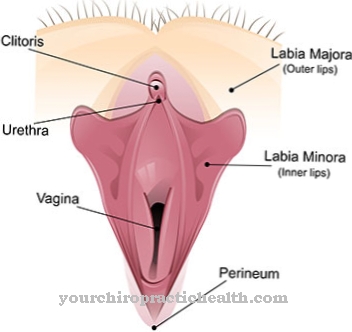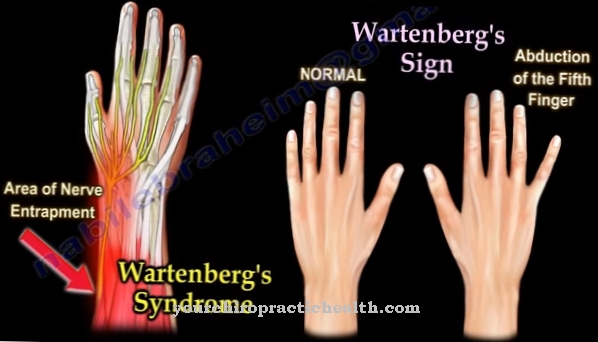The Acalculia, or. Arithmetic weakness is the loss or impairment of already acquired numeracy skills, which in the majority of cases can be traced back to damage to cortical centers, especially in the left hemisphere. Accordingly, acalculia must be differentiated from dyscalculia, which is usually identified as a specific developmental disorder in childhood or school age.
What is weakness in numeracy?
.jpg)
© Robert Kneschke - stock.adobe.com
As Acalculia is an acquired impairment in dealing with arithmetic quantities (arithmetic operations, handling numbers), which is caused by damage to the cortical centers of the brain, usually the left hemisphere (hemisphere).
While other intelligence is not restricted, acalkulia can manifest itself in everyday life, among other things, on the basis of difficulties in dealing with money, telephone numbers and / or times, when estimating distances, price discounts or quantities and on the basis of impairments in the processing of arithmetic symbols. Depending on the severity of the underlying lesion, heterogeneous forms of arithmetic weakness can appear.
While some only impair complex arithmetic arithmetic operations, others affected by acalculia may limit elementary basic arithmetic operations such as adding or subtracting single-digit numbers.
causes
The rather rarely occurring primary Acalculia can be caused by damage to the language-dominant cortex as a result of an insult (stroke). The impairment known as secondary acalculia, on the other hand, is observed more frequently and can be associated with a reduction in the performance of the brain due to memory disorders, attention disorders and a pronounced tendency to perseveration (pathological perseverance or lingering on a thought or a linguistic utterance).
Acalculia is also associated with damage to the parietal and temporal lobes in agraphia and finger-foot-toe agnosia. In addition, acalculia occurs as a symptom of Gerstmann's syndrome (also angularis syndrome), which also manifests itself in agraphia, finger diagnosis, right-left disorder and in which the left angular gyrus is usually affected.
Since arithmetic operations are partially controlled by language functions, acalculia correlates in many cases with aphasia, which can occur as a language disorder caused by the central nervous system, for example as a result of strokes, tumors, cerebral hemorrhage, inflammation or intoxication.
Symptoms, ailments & signs
The main symptom of acalculia is the presence of an acquired impairment in dealing with numbers and other arithmetic quantities. How this arithmetic weakness expresses itself depends primarily on the extent of the neurological disorder present. For some of those affected, the impairments only become apparent during complex arithmetic operations.
In other cases, the acalculia shows up through difficulties in dealing with numbers, distances, telephone numbers, times and dates. Due to their arithmetic weakness, those affected often cannot handle money because they cannot correctly assess price discounts and quantities. Problems with counting arise especially when aphasia is present at the same time.
In addition, the auditory understanding of numbers is often limited. Those affected repeatedly make mistakes in reading and writing as well as arranging numbers in a regular manner. They also have difficulties with arithmetic, since the ability to perform operations on numbers is severely impaired in acalculia.
Arithmetic symbols are often confused or not understood. In serious cases, the ability to calculate is not available at all or is often limited to individual basic types of calculation. The other intelligence of those affected is not further restricted by the disease.
Diagnosis & course
To determine a Acalculia There are various screening methods in which the potentially impaired arithmetic operations can be checked in specific tests.
Possible screening methods are the so-called number processing and calculation test (ZRT) in connection with a test for cognitive estimation and the NPC test (Number Processing and Calculation Battery). In general, the most important representations of numbers and Transcoding methods (for example, the Arabic number “26” can be assigned to the phonetic sequence “twenty-six”), the arithmetic basic arithmetic operations as well as counting, approximate calculations (estimate and rough calculations) and the numerical span are tested.
In the differential diagnosis, acalculia should be differentiated from dyscalculia, dementia, and numerical illiteracy. In order to be able to rule out premorbid underperformance, the performance level in the run-up to the lesion should also be taken into account. In general, the prognosis and course of acalculia depend on the type and location of the underlying lesion. Although the spontaneous development of acalculia has not been conclusively investigated, an improvement can generally be assumed after five to six months after the triggering event (including a stroke).
Complications
An acquired weakness in numeracy is not necessarily associated with complications. Most of the time, however, the memory impairment has a serious cause, such as a stroke or tumor, that can cause further problems. Many people suffer from persistent attention deficit disorder or have difficulty concentrating after the incident.
Often neurological deficits are added and the quality of life of those affected decreases overall. The numeracy itself can cause complications if the patient had a lot to do with numbers at work before the incident. Occupations in accounting, for example, can usually no longer be carried out with a mathematical weakness. Even after the acalculia has receded, those affected have to be taught in from scratch.
This represents a great psychological burden, which, especially with serious accompanying symptoms, cannot be overcome without outside help. There are usually no complications in therapy. Occasionally, however, sedatives and stimulants are prescribed and these are always associated with side effects. The drugs that are prescribed to treat the underlying disease can also cause discomfort and occasionally cause interactions and allergic reactions.
When should you go to the doctor?
A numeracy weakness is noticed nowadays in the development and growth process of the child. Parents and teachers are responsible for organizing help and medical support in the event of irregularities. In some cases, acalculia occurs in an adult human. This was preceded by a triggering event such as a stroke or damage to the brain. Due to the underlying disease, the person affected is already receiving medical treatment and should address changes in their mathematical skills.
Help is needed as soon as the understanding of numbers is disturbed. The severity of the irregularity is different for the sick. Anomalies can occur with simple or complex arithmetic tasks. A doctor should be consulted for clarification as soon as there are peculiarities in everyday life in addition to a restriction in school performance. In the case of poor management of money or the inability to assess distances and quantities, a visit to a doctor is recommended.
If times cannot be read, understood or implemented in a meaningful way in practice, this is worrying. If you have problems with the date, the assignment of house numbers or the operation of the telephone, you should see a doctor. Repeated errors in reading and writing numbers are another sign of an irregularity. If there is a lack of aural understanding of numbers, a doctor is also required.
Treatment & Therapy
The therapeutic measures are aimed at one Acalculia either the restitution (restoration) of the impaired functions and abilities or a reorganization. In the case of acalculia, the therapeutic measures aim either at the restitution (restoration) of the impaired functions and abilities or a reorganization in which other intact cognitive functions are used in a compensatory manner become.
As part of restitution, the lost knowledge is primarily trained through intensive training units in which the damaged functions, in particular transcoding and the renewed retrieval of the arithmetic knowledge that has already been stored, is trained in order to establish a stable link between the specific arithmetic problem and the correct solution .
It is recommended to consider everyday-specific exercises (including reading the time, dealing with money and calculating change) as well as job-related tasks when reintegrating into working life as a rehabilitation goal. In addition, you should start at the level of difficulty from which the specifically affected person shows impairments.
Therapeutic approaches that aim to reorganize arithmetic competencies are used to convey specific strategies and basic arithmetic rules (e.g. 5 x 6 = (5 x 10) - (5 x 4)) to compensate for the functions affected by the calculia within the framework of Practice units aimed at.
You can find your medication here
➔ Medicines against concentration disordersprevention
One Acalculia can only be prevented to a limited extent. For example, as part of arteriosclerosis prophylaxis, the risk of a stroke and thus of possible acalculia can be reduced.
Aftercare
In the case of arithmetic weaknesses or acalculia, the aftercare aims to consolidate the newly acquired feeling for numbers and mathematical processes. Unlearning these skills and the recurrence of the weaknesses in numeracy are prevented. The sooner the learning disability is diagnosed, the better the healing possibilities.
The psychological aspect is no less important in the case of a mathematical weakness: Children with acalculia often suffer from fear of school or from psychosomatic complaints such as nausea before starting school or anxiety during math lessons. Self-confidence can be impaired if, despite repeated arithmetic exercises, no success is achieved.
If classmates experience the child's learning difficulties in class, the risk of bullying is also very high. If one or more of these situations apply, a psychologist must be consulted in order to counteract any permanent damage to the child's self-esteem. In the therapy lessons, ways are worked out together with the child to strengthen self-confidence.
You can do that yourself
In order to gradually restore numeracy in the case of acalculia, intensive training is necessary. The level of difficulty has to be determined individually by a doctor and increases gradually. Exercises that are tailored to the everyday life of the person concerned are best suited. This includes reading the time and calculating with money. More difficult connections can be introduced later.
If you have a pronounced arithmetic weakness, it is a good start to first integrate simple arithmetic rules into everyday life. Special learning material for arithmetic weaknesses can be used for this purpose. Another possibility are school books. Group training with other sick people is also recommended. If this is not possible, relatives who are not sick can also help the sick person. You can support the sick person individually. For example, mental arithmetic or writing down longer numbers can be practiced.
Depending on the severity of the mathematical weakness, support in everyday situations is also necessary. Since acalculia is often the result of a disorder of the left brain hemisphere, it is advisable to train it specifically. Not only arithmetic tasks, but also language exercises and other brain teasers can be used for this.

.jpg)

.jpg)























